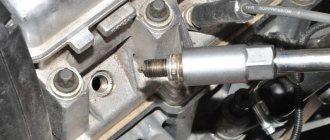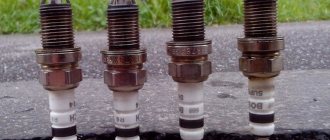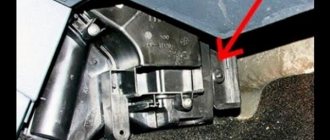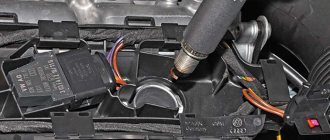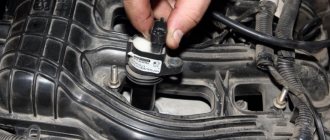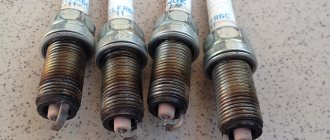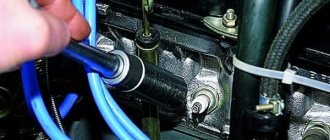Spark plugs are the most important element in the operation of any car. Their purpose is to ignite the fuel-air mixture in the combustion chamber. The spark plug is the final element on which the entire car ignition system operates. Spark plugs are consumables and require periodic replacement during operation. This article will provide information on when it is necessary to change spark plugs, how to do it yourself, and will also indicate some of the features of this procedure for different car brands.
When to change spark plugs
To understand the specific timing of replacing spark plugs, you need to refer to the technical regulations of the car on which this operation must be performed. This is done due to the fact that depending on the make and year of manufacture of the car, the requirements vary.
It is worth reading the manual and listening to the requirements of the manufacturer. But personally, I would subtract minus 10-15 thousand km from this replacement period. taking into account weather conditions, gasoline and everything else.
What's wrong with the weather and how does it affect spark plugs? You ask. Very simple. Partial dust, sand, dirt, water from the road gets onto the engine. In the process of replacing spark plugs, we observe sand in the wells, oil that flows from under the gasket (Ford), and even water (from above from under the plastic where the wipers are). It's different on different cars. Since the engines are located differently.
Drilling and unscrewing
If the first two methods do not help, you will need to remove the cylinder head cover and drill a hole in the spark plug holder. A special sleeve of the appropriate diameter is screwed into it, having either a hexagonal notch or a thread on the inside. This operation cannot be carried out on the engine, since there is a high risk of chips and metal dust getting into the working area of the cylinder.
It is better to take the cylinder head cover to a turning workshop, where the hole and installation of the “screw plug” will be done as carefully and accurately as possible, without damaging the thread. In any case, disassembling the cylinder head can serve as an excellent reason for routine repairs of the gas distribution mechanism, piston system and replacement of gaskets.
Spark plug malfunctions
Spark plugs and glow plugs fail sooner or later. This can be caused by various reasons - natural aging, use of low-quality fuel and mechanical damage. Let's take a closer look at the signs and reasons for their failure.
Symptoms of a problem
Let's start with spark plugs, as they are more common. So, signs of their malfunction include:
- difficulties when starting the engine (usually this is accompanied by prolonged operation of the starter);
- the engine “troits” (the car jerks when moving, picks up speed poorly, it lacks traction and power);
- significant increase in fuel consumption;
- increase in the amount of CO in exhaust gases;
- decreased engine dynamics (insufficient speed).
Spark plug device: 1 - thread; 2 — end of the body (rim): 3 — side electrode: 4 — central electrode; 5 — thermal cone of insulator (“skirt”)
It is worth mentioning here that the listed signs may indicate other engine malfunctions. However, if at least one of them appears, it is necessary to check the condition of the spark plugs, especially since this is not difficult to do.
Now let's move on to the glow plugs. Signs of their failure are:
- Difficulty starting the engine in cold weather. In particularly difficult cases, it is impossible to start the car at all.
- The engine runs rough at idle speed.
- White smoke comes out of the exhaust pipe (simulating a rich fuel-air mixture);
- Inoperative spiral indicator on the dashboard. If it does not light up, then there is a high probability that the temperature sensor or fuse has failed, but sometimes it can also indicate a failure of the spark plugs. But when this light is constantly on, then most likely the thermal switch needs to be replaced. If this is not done in time, the glow plug may fail completely.
Now let's move on directly to the reasons why the spark plugs failed.
Causes of malfunctions
Let's start again with the spark plugs. The reason for their partial or complete failure may be:
Worn and new spark plugs
- natural wear and tear;
- the presence of a large amount of soot;
- presence of oil on the electrodes;
- varnish deposits;
- slag deposits;
- failure of the central electrode;
- candle melting;
- spark plug connector wear.
As for glow plugs, the causes of their malfunctions may be:
- natural wear and tear;
- low quality diesel fuel (presence of moisture or various impurities);
- problems with electrical wiring;
- problems with the electronic control unit.
As a rule, one spark plug fails. If two spark plugs are faulty at once, the engine simply will not start. But if all the existing ones fail, then the reason must be sought, most likely, in the ECU.
Bottom line
There are many ways to check spark plugs. Some of them do not even require removing the spark plug or additional devices. This allows you to easily check spark plugs at home. In other cases, you will need a multimeter or a gun, removing the spark plug. The most correct way would be to check the candle on a stand, but you will have to pay for it. In some cases, the cost of the service is more than a new candle, which makes the operation with the stand pointless.
Read more useful information and interesting facts at!
Spark Plug Replacement Tools
You don't need many tools to replace spark plugs. The most important of them is a socket wrench with extension and spark plug socket. Candle sockets come in two sizes: 5/8" (16 mm) and 13/16" (21 mm). Most spark plug sockets have a rubber insert that prevents the plug from slipping. You may also need a universal joint if the spark plug is installed in a hard to reach place. The universal joint allows you to tilt the key along one axis and rotate it around another axis. If you don't have enough space to work with a wrench and extension to get to the spark plug, then a universal joint may come in handy. When replacing spark plugs, it is important not to overtighten them. Over-tightening the spark plug can damage the spark plug itself or the cylinder head threads. To avoid over-tightening, use a torque wrench. Torque wrenches indicate the amount of torque you apply when turning the wrench. Although almost all modern spark plugs are sold with a preset gap, it is better to have a gauge on hand. A gap gauge allows you to ensure that the spark plug center electrode is the correct distance from the ground electrode. It is this part of the candle that gives the spark. You may also need spark plug cap pliers, a rubber tube, a clean rag, rubbing alcohol, anti-seize agent, and a can of compressed air. The absence of these things is not critical, but they can make your work easier.
This is interesting: How to make a car window defroster (anti-ice) with your own hands?
Next, we will talk in detail about how to change spark plugs.
How to replace spark plugs
The standard technological sequence of operations includes:
- Turn off the ignition, remove the negative terminal of the car battery.
- Freeing access to spark plugs, removing individual ignition coils.
- Dismantle the spark plugs, put them on a sheet of paper, signing the number of the cylinder that it served. In this case, it is better to use torque wrenches with a long head of the appropriate size. If the threaded connection is heavily coked, it is necessary to use special means.
- Assess the condition of the spark plugs. If there is heavy carbon deposits on the spark plugs, signs of overheating or oiling, you should consult a motor mechanic or search for information on the Internet about possible causes of engine system malfunctions. They need to be eliminated. If this is not done, the new kit may become unusable after a couple of thousand kilometers.
- Install a new kit. The average torque wrench force is between 15 and 20 Nm. It is better to look up the exact value in the reference book. Under-pressure, as well as over-squeezing when installing spark plugs, can lead to serious consequences. If the service station does not use a torque wrench when installing spark plugs, you must refuse their services.
- Install the dismantled engine components, attach the battery terminal, and test run the engine.
Preparing to replace spark plugs
Before removing the coils (or wires) and the spark plug itself, it is necessary to thoroughly blow off the working surface so that the dust and sand that accumulate on it do not get inside the cylinder and damage the cylinder mirror and elements of the piston group. This must be done with a professional, powerful compressor.
Remove debris and dirt before replacing spark plugs
The compressor that many people carry in their car to inflate tires will not work. The air flow needs to be strong. The price of the issue is the health of the piston group.
If there is no compressor, but you need to unscrew the spark plugs, you can try the following scheme: unscrew the spark plug a few turns and clean the surfaces with a brush or brush. However, this method cannot be used on all cars. You can also use a vacuum cleaner. However, none of these methods guarantee clean cylinders.
NGK spark plugs
Checking with a gun
Checking the spark plug with a gun
There is a special device for checking spark plugs, which looks like a pistol. The principle of testing is quite simple - pressure is created, after which voltage is applied to the spark plug. If the light on the gun lights up, then it is working.
To check the serviceability of the spark plug using the device, perform the following steps:
- Insert a spark plug into a specially prepared socket.
- We put a cap on its other edge.
- We press the trigger and look at the indicator light.
However, this method remains not entirely correct, since, in fact, only the presence of a spark is determined. At the same time, the spark may be weak or form not on the electrodes, but on the body. So it’s better to check it in parallel using the methods described above.
Features of replacement by brand
The above generally describes a standardized procedure for replacing spark plugs, which is typical for all vehicles without exception that run on internal combustion engines. Knowing the basic principles, it will not be difficult to make a replacement on any make of car. Difficulties can arise only when searching for the spark plugs themselves (on some machines, in order to get to the spark plugs, you need to remove and disassemble many obstructive elements), as well as if their location is inconvenient.
For each car, depending on the make, year of manufacture and engine type, strictly defined sections are required. Please refer to the instruction manual for specific markings. It is not permissible to use unsuitable spark plugs on a car. This entails major damage to related elements.
Replacing spark plugs for Volkswagen Polo, Jetta, Passat, Tiguan
The features of engines from the TSI series, which are installed on Volkswagen cars, require the most careful approach. Damage occurs to the rubber tips of the ignition coil.
The manufacturer has provided for the possibility of such breakdowns, so the coil tips are sold separately and replacement will not be so expensive.
To replace the spark plugs, you must remove the pipe. To do this, you need to squeeze the clamp with pliers and move it. Do this at both ends of the pipe, then you can remove it. To prevent contamination, it is better to cover the opening of the open air pipe with a napkin. Then access to all 4 coils will be open.
Next, disconnect the ignition coil plug. There are also some peculiarities here: the lock is tight, if you can’t start it with your hands, you can help with a flat-head screwdriver. Now you can unscrew the bolt securing the coil and remove it. It is not so easy to get it out because the rubber tip gets stuck. If the coil does not reach, you need to loosen it a little. In addition, you can use rounded pliers - slide them under the coil, lift it, clamp it and pull it up, turning it left and right.
Further, the process of replacing spark plugs differs little from the standard version. But before installing the coils in place, it is necessary to lubricate them with high-temperature grease so that there are no further problems with their removal.
In the case of an MPI engine, the spark plugs should be located under the air filter cover.
Replacing spark plugs for Renault Duster, Logan, Sandero
On the Renault Duster 2.0 L F4R there is a small feature that concerns the leftmost coil. The phase regulator valve is attached close to it, so in order to get this coil, you need to unscrew the phase regulator with a screwdriver. The spark plug wrench must have a magnetic or rubber head, since the spark plugs are in a recess and it is not possible to get them out with a regular head.
The problem with most Renaults is the weak threads of the coil bolts, so you need to unscrew them carefully.
This is interesting: Handbrake: self-adjustment of cables
On the K7M engine, when removing the wires, you must remember their location so as not to confuse them later.
Replacing spark plugs for Kia Rio, Sid, Sportage, Serato
On Kia cars, as a rule, replacing spark plugs occurs without difficulty or problems, since the spark plugs are conveniently located and the coils are easily removed.
Thus, candles are the most important element of a car, which can say a lot about its condition. It is recommended to change spark plugs every 15 thousand km. mileage It is better not to wait for interruptions in engine operation and change spark plugs preventively.
The main rules for replacing spark plugs are: cleanliness of the working cylinders and correct tightening of the spark plugs.
Why do the SZ get jammed?
A correctly screwed spark plug simply cannot stick to a normally running engine. Most extraction problems are a consequence of incorrect operation. Among the main reasons for the difficult progress of the SZ are:
- untimely replacement, as a result of which the SZ became stuck under the influence of prolonged mechanical and thermal loads;
- poor quality material from which the candle is made;
- excessive tightening force;
- installation of SZ on a hot engine;
- foreign particles on the threaded connection (the well was not cleaned before tightening).
What happens if you don’t change or clean the spark plugs?
It is necessary to dwell in detail on the reasons why it is prohibited to use candles containing certain problems.
You should start with carbon deposits on the insulator. The spark plug is located inside the combustion chamber, where there are particles of oil that lubricate the cylinder and piston. It comes into contact with soot during the combustion of a rich mixture. And soot has the ability to be deposited on fairly cold parts of the metal. Therefore, the combustion chamber of any engine becomes covered with plaque. The soot layer on the chamber walls grows until a certain point, after which the growth stops. Because the rest of the plaque heats up to such an extent that the soot is burned out from there. Therefore, throughout the entire service life of the engine, the soot layer remains of a certain constant thickness. Soot is deposited on the metal part of the spark plug (but only on the side with which the spark plug is screwed into the chamber). This is noticeable by the characteristic even plaque, which in that place is natural and normal.
If the spark plug operates at normal temperatures, with a balanced fuel-air mixture, with a normal amount of oil, that is, in the design mode, then the central insulator remains white and clean, like on a new spark plug. This happens due to the self-cleaning of the central insulator from soot, which depends on the temperature to which this central insulator is heated. The higher the temperature of the central insulator, the easier and faster traces of soot burn from it, and the central electrode remains light.
At a temperature of 400–500 °C, carbon deposits disappear - the candle cleans itself.
A clean insulator ensures little spark leakage. The insulator darkens if it does not heat up to a temperature at which it would clean itself. It is very important that the insulator is clean. If it is covered with soot, then part of the spark charge will pass through the soot deposits, and only the other part between the electrodes, since soot is a semiconductor.
Thus, a dirty spark plug (insulator) makes the spark unstable. When the throttle valve is opened sharply, when the pressure at the end of the compression stroke is maximum, this black plug may begin to work intermittently and not provide sufficient power, sufficient throttle response, or economy. A clean spark plug will be guaranteed to ignite both rich and lean fuel-air mixtures and not misfire.
There are situations in which one half of the insulator is clean and the other is dark. This happens due to the fact that such a candle is affected by a high oil content. The clean side of the spark plug is facing the exhaust valve, and the dark side is facing the intake valve. If the seal on the intake valve (oil deflector) is damaged, that is, along with the supply of fresh mixture, it supplies drops of oil, which one side of the insulator does not have time to cope with. In this case, the oil seals on the intake valves require repair. This situation also leads to malfunctions of the candle.
However, black spark plugs do not always require replacement. You can usually get by with a simple heat cleaning. Once again: carbon deposits do not form due to a faulty spark plug. After cleaning the spark plug, you can continue using it.
The next reason for spark plug failure is corrosion of the electrodes. With each discharge that passes between the side and central electrodes, a piece of metal evaporates from their surface. In this regard, over time the electrode wears off. Thus, the distance between the electrodes increases. It becomes more difficult for the ignition system to produce a good spark.
Additional information: the gap between the electrodes increases by 0.015 mm for every 1000 km of vehicle mileage.
A spark plug with an increased gap and worn-out electrodes exhibits high resistance. Such elements as the module, distributor, and ignition coil (depending on the device of the car) experience a huge load. If exposed to abnormal load, these elements may simply burn out. Timely replacement of spark plugs and wires (old worn wires also provide resistance) can save you from complex and expensive repairs.
In addition, it is reliably known that old spark plugs can increase fuel consumption by up to 30%. Therefore, refusing a planned replacement of spark plugs will not lead to budget savings, but rather the opposite.
Location
The spark plugs are screwed along the threads of their body into the block head. The exact location in the combustion chamber is determined by considerations of optimal ignition, but in civilian vehicles, layout considerations are primarily taken into account.
Therefore, the established scheme is that on four-valve cylinders the spark plugs are placed vertically in the camber of the intake and exhaust valves in the center of the combustion chamber. With a single-row valve arrangement, the housing is screwed in from the side at an angle, directly adjacent to the incoming fuel from the intake valve.
Important Tips
- The spark plugs must be replaced with a new set, even if only one such part has failed.
- Before the replacement procedure, wash the car yourself or at a car wash. Such measures will significantly reduce the possibility of dirt entering the engine cylinders.
- High voltage wires also change completely, that is, their entire set must be replaced.
- High quality spark plug connectors have rubber seals. They help to fix the candles well.

